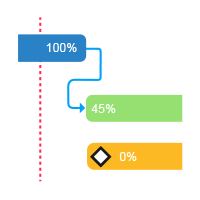Project scheduling is one of the main activities of project planning and represents a structured planning process to ensure the success of the project.
It is summarized in a document that describes all the work necessary to deliver the project on time and with success.
A project, in fact, is composed by many activities and each activity includes a beginning and an end. In the same manner, people have different times and different availabilities. All of this must be rationally included in a project schedule, often supported by Gantt charts to clearly visualise timelines and dependencies.
CONTENT INDEX
- How to plan a project
- 1. Plan the scheduling management
- 2. Define the activities
- 3. Sort the activities
- 4. Estimate the duration of the activities
- 5. Develop the schedule
- 6. Control the schedule
- Best practices for project scheduling
- New trends in the management of the project schedule
- Iterative scheduling with backlog
- Scheduling on request
- Project Management Software: why choose Twproject
The project management program is a document that outlines the work to be done, the order in which it must be done, what resources are required, how they will be distributed, and how long they will take to work on the various activities.
Thanks to digital tools, the programme is an excellent way to keep track of progress and changes in real time.
Project scheduling also helps project managers communicate and deal with team members as well as stakeholders and also helps keeping the project on track.
Specifically, a project schedule includes:
- Milestones
- Deliverables
- Tasks required to complete the results
- Dependencies between tasks
- Requirements and allocation of resources
- Deadlines, time intervals and duration of activities
As it is he case in many aspects during project management, also scheduling is performed in various steps.
When creating a program, project managers estimate work, timing, and resources. However, all this information is subject to change once the project is in progress.
Scheduling is usually created during the initial phases of the project, but is detailed throughout the project life cycle.
How to plan a project
There are three basic questions for project scheduling:
- What must be done?
- When will it be done?
- Who will do it?
Once obtained the answers to these questions, it is possible to start the project schedule in details.
Here are the steps necessary for managing a project’s planning.
1. Plan the scheduling management
in this beginner phase, the directives and procedures for the development, management and control of the project schedule are established.
In this phase, you can organize a brainstorming meeting, where you can create a draft of the program or obtain a list of ideas.
Moreover, during the meeting, it is useful to ask for feedback from the people who will actually work on the project.
In fact, team members have a unique vision of how much time they will need in order to perform the tasks and what their skills and knowledge are.
During this meeting it is also good to acquire inputs from the client and other stakeholders.
2. Define the activities
This is the phase in which the specific activities and tasks to achieve the project goals are identified, ie the tasks to produce the deliverable and complete the project with success.
3. Sort the activities
In this phase, we identify the relationships and interdependencies between all the project activities. To do this, it is necessary to consider how the activities relate to each other, in addition to any time or resource limits.
4. Estimate the duration of the activities
In this phase, we proceed with the estimation of the activities identified matching them with the estimated resources.
It is probably one of the most difficult parts of the project schedule, but it is also one of the most important as it has a huge impact on the total cost.
The term “duration” refers to the number of working hours, days, weeks, or months that team members need to complete a given activity.
Properly estimating the duration is important for both parties: this keeps customers happy, as work proceeds according to plan, and keeps team members happy, as they can easily meet deadlines.
5. Develop the schedule
In this phase, we proceed to analyze all the previous points in order to create the definitive project scheduling model.
Gantt charts are often used to keep track of planned activities and deadlines.

Want to give it a try?
Create your first Gantt chart in Twproject and try tracking a real activity of your team.
Try it out now!
6. Control the schedule
In this last phase, the project status is monitored throughout its life cycle in order to update and modify the schedule as the details become clearer.
For simpler projects with a narrower scope, the points from number 2 to number 5 are so connected that they can be performed by one single person.

Best practices for project scheduling
Once you have seen the basic steps for creating a project schedule, let’s see what are some best practices.
These are based on the opinion and experience of renowned project management organizations such as the Project Management Institute (PMI), as well as other project management experts.
- Be clear and detailed. If this were not the case, team members would not know exactly what to do and when to do it. The more detailed the project schedule is, the more effective the work will be. But be careful not to fall into the opposite error, which is overloading the team and the stakeholders with too much information.
- Make sure that the workload foreseen in the project schedule is balanced.
It is important to assign the right people to the right tasks and that the workload is distributed evenly. Moreover, it is advisable to ask the team members to review the program in order to make sure the workload is reasonable. This is particularly crucial in organizations where budgets are limited and / or staff has limited availability. It is also recommended to regularly review all the tasks the team is working on in order to ensure that distribution is maintained appropriately. - Building the schedule based on results and milestones, not around activities.
It may be instinctive to build the program around the tasks, because they represent the actual work of the team, but there is nothing more wrong. If the planning is built around the activities in fact, it is difficult to say whether the requests for changes fall within the project or not. Activities can be carried out in a number of different ways and can have a variety of outcomes.
Milestones, on the other hand, are quantifiable and follow certain standards and criteria. In addition, creating a program on these elements helps you stay in line and to achieve the project goals. - Prepare for change. It is not a question of whether the program will change, but when and how it will change. Needs, events, risks and activities of the parties constantly change in the management of the projects. For this reason, the project schedule is a work in progress throughout the life cycle of a project. When drawing up the schedule, it is appropriate to make assumptions about what changes might occur, when, and what kind of effect they might have on the project. Including extra time for important tasks allows you to make changes without sending the project off course. However, it is also necessary to create limitations in order to prevent changes that do not address the scope of the project.
- Organize regular team meetings. Meetings with the team, the clients and the key stakeholders will help to manage the program more effectively. During these sessions, all the parties can ask questions, get updates on the progress of the activities and make decisions about the estimates and work.
New trends in the management of the project schedule
Considering the current global market, highly competitive and highly flexible, managing the project schedule properly becomes even more important.
In particular, there are two emerging practices for project scheduling:
Iterative scheduling with backlog
In this model, the requirements are reported in customer records and prioritized prior to product development. Ideally, some of these deliverables can be completed and delivered to the client during the work, instead of doing everything at the end of the project.
The great advantage of this method is that it accepts and applies the changes during the life cycle of the project, therefore during the development of the deliverables. It is therefore an iterative program.
Scheduling on request
Unlike the previous one, this approach is not based on a schedule developed previously for the requirements and product development. Here, the requested job is reported into a backlog in order to be executed when the resources become available.
To give an example, it is a situation like: “Here is a list of things to do. Good! Maria is available to do the work and can finish it in a week“.
Project Management Software: why choose Twproject
Another trend in project scheduling is the use of project management software tools.
While project scheduling in the past was carried out via printed calendars or shared worksheets via e-mail, today most organizations and teams use project planning tools and software.
Typically, project scheduling is just one of several features that project management software can have.
The use of a project management software helps project managers and team members to communicate, track, and review the schedule more efficiently and effectively, thus leading the project towards success.
Discover how Twproject transforms project scheduling into a simple, collaborative and fully integrated experience:
- Interactive and collaborative Gantt charts
Create, edit and share your Gantt charts in just a few clicks. The whole team can update timelines in real time, avoiding version errors and overlapping tasks.
- Keep track of hours and costs in real time
Automatically record the time spent on each activity. Instantly calculate project costs and compare them with the planned budget, so you always have margins and expenses under control.
- An integrated planning process with team chat and automatic notifications
Communicate directly on the task via internal chat: comments, attachments and mentions always remain linked to the correct activity. Receive automatic alerts when milestones expire, assignments change or delays occur.
- Customisable dashboards to monitor milestones, resources and risks
Build your ideal dashboard by choosing charts and widgets: from milestone progress to workload of team members, to early warning of potential risks. Share one-click reports with stakeholders and customers for total transparency.
With Twproject, you not only optimise your planning process, but also provide your entire team with an excellent way to collaborate, track activities and ensure the success of every project.




